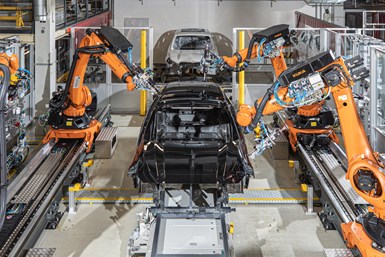Finishing Another Year — Looking Back at the Trends of 2023
Products Finishing reflects on a year of reporting on the surface finishing industry and looks ahead to what may be in store for 2024.

It’s that time of year — the holidays offer a time to reflect upon the work and interactions of the past 12 months, while contemplating what new challenges and opportunities might be ahead. To me, 2023 felt like a year of careful progress. Coming out from under the shadow of a time that seemed hampered with supply chain disruptions and acute workforce shortages, it feels like we are slowly moving the needle in a positive way. Granted, there are still plenty of challenges, but it is also a time filled with plenty of innovation.
As we look back at some of the finishing trends of 2023, a good place to start is by digging into some of the technology advancements discussed in the “Trends in Industrial Coatings” article featured in the January 2023 issue of Products Finishing. short.pfonline.com/coatingstrends23
Featured Content
Along with these emerging technologies, there are also numerous manufacturing megatrends that are shaping our industry today.
Automotive
It’s been a roller coaster of a year for the automotive industry. From the recent United Auto Workers (UAW) strike to investments in the production of new energy vehicles including EVs and hybrids, there is a great deal of change that automakers are facing. Only a few years ago, the idea of EVs comprising a large portion of the automotive market seemed unrealistic. Concerns over the range of battery-powered EVs and the lack of supporting infrastructure made EVs seem like a pipe dream. While those challenges are still important considerations, today’s conversations center less around if EVs will be successful than how to make them successful — and how to build the infrastructure to better support them. In 2020, EVs made up 4% of the automotive market share. In 2022, that number jumped to 14%. EVs are expected to surpass 2/3 of global car sales by 2030.
So, where do the opportunities for finishers lie in the increasing production of these vehicles? That’s a question that PF has been asking often as we talk to finishers and suppliers.
Collaboration
Several megatrends in manufacturing are pushing the need for new material solutions. Trends toward lightweighting and electrification are changing some of the traditional materials that find their way into applications. Increased use of plastic, composite and additively manufactured parts are driving the need for collaboration between OEMs and tier suppliers with finishers for surface finishing solutions and coatings. Finishers who actively seek out ways to partner with potential customers to find unique surface finishing solutions for new applications are more likely to work their way into new programs.
Automation
Workforce difficulties are nothing new for the finishing community. Challenges with finding and retaining skilled labor persist and many finishing operations are increasingly seeking ways to implement automation solutions to help streamline some of their processes. However, identifying the right areas to automate can be daunting. PF’s July 2023 issue devoted several stories to this topic.
Alternative substrates
Trends toward the lightweighting of materials and the increasing use of non-traditional methods of part fabrication, such as 3D printing, have led to the need for finishers to consider a variety of substrates.
Environmental and regulatory challenges
Regulatory compliance is a constant source of concern for finishers. Tightening regulation of such substances as hexavalent chromium and PFAS chemicals has long been an important topic for the finishing industry. In 2023, the California Air Resources Board (CARB) passed legislation that will implement a phase-out of hexavalent chromium use for finishing operations. As these phase-out deadlines loom large, many finishing operations are exploring hex chrome alternatives.
Looking ahead
As the finishing industry looks to the horizon, it faces myriad challenges and opportunities. As an ever-widening variety of material solutions find their way into manufacturing processes, the opportunities for creative surface finishing solutions will continue to grow. It is truly an exciting time to be a part of this vital industry.
On behalf of PF, I wish you a prosperous and successful new year.
RELATED CONTENT
-
Smart Workholding Device Measures and Monitors
Sensor and IIoT technology combine to enable these chucks and mandrels to automatically monitor workholding parameters and measure part features to ensure process stability.
-
Automating CNC Lathe Part Loading/Unloading
Read about how you can automate the loading/unloading of your CNC lathes to reduce the labor cost on longer running jobs.
-
Handling Parts In A Robotic Cell
Here’s a review of the workholding and workhandling challenges a shop faces as it moves a part through a robotic cell, from serving up the blanks to the transfer of the final workpiece to post processing and gaging. Productivity, Inc. takes the reader through a few of their cells that they've installed using Fanuc robots and a variety of other machine tool equipment.















